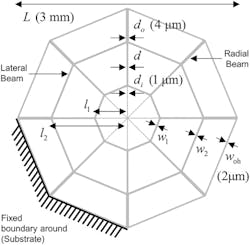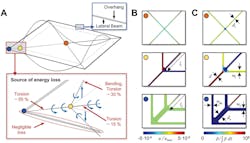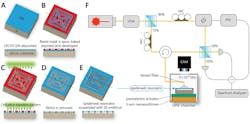MEMS Spiderweb Forms Super-Sensitive, Noise-Resisting Vibration Sensor
What you’ll learn:
- The challenges of devising highly sensitive sensors despite ambient noise.
- How the spiderweb was used as inspiration for a vibration sensor.
- Why and how machine learning was used to optimize the design.
- How the optimized design was fabricated and tested.
All sensors designed for ultra-low-level signals share a common problem: ambient noise. Whether thermal, electrical, vibration, or other, the resultant poor signal-to-noise ratio (SNR) can easily overwhelm the unknown signal of interest. Thus, even having a super-sensitive sensor may not yield meaningful sensing improvement.
Recognizing this dilemma, a team of researchers from Delft University of Technology (Netherlands, often called TU Delft) designed one of the world’s most precise microchip sensors. Especially fascinating and useful, it can function at room temperature rather than need to go close to absolute zero to minimize the effect of noise.
By combining nanotechnology and machine learning, and inspired by nature’s spiderwebs, the team was able to devise a nanomechanical vibration sensor featuring extreme isolation from everyday noise. They then tested their proposed design by constructing a microchip version using a nanometer-thick film of silicon nitride (Si3N4) that has the desired material properties of high intrinsic stress, yield strength, temperature stability, and chemical inertness, plus widespread use experience in nanotechnology.
Merging Nanotech and Machine Learning
Richard Norte and Miguel Bessa, who led the research, were looking for new ways to combine nanotechnology and machine learning and were inspired by nature. Noted project co-leader Richard Norte, “I’ve been doing this work already for a decade when during lockdown, I noticed a lot of spiderwebs on my terrace. I realized spiderwebs are really good vibration detectors, in that they want to measure vibrations inside the web to find their prey, but not outside of it, like wind through a tree. So why not hitchhike on millions of years of evolution and use a spiderweb as an initial model for an ultra-sensitive device?”
Since the team did not know anything about the complexity of spiderwebs, they decided to let machine learning guide the discovery process. Project co-leader Miguel Bessa added, “We knew that the experiments and simulations were costly and time-consuming, so with my group, we decided to use an algorithm called Bayesian optimization, to find a good design using few attempts.”
Team member Dongil Shin then implemented the computer model and applied the machine-learning algorithm to find the new device design (Fig. 1).
1. Overview of the Bayesian optimization process for designing the spiderweb nanomechanical resonator: (A) designs and simulated mode shapes at the corresponding iterations highlighted by circular markers in the remaining figures. (B) Evolution of the quality factor Qm (the red markers and red line indicate the highest quality factor until that iteration). (C) The frequency fm. (D) The distance from a previous optimized point to the point considered in that iteration. (E) Values of the six design parameters at every iteration, providing an idea of how the designs change in the optimization process. The abscissa for (B)-(E) is the same and corresponds to the design iterations as the optimization process evolves. The blue region in (B)-(D) corresponds to the 40 initial designs that were randomly selected—that is, before starting the Bayesian optimization process—while the red region corresponds to the Bayesian optimization iterations.
To the researcher’s surprise, the algorithm proposed a relatively simple spiderweb out of 150 different spiderweb designs, consisting of only six strings put together in a deceivingly simple way (Fig. 2).
2. Spiderweb nanomechanical resonator model with Nr = 8. The design parameters are d, w1, w2, l1, and l2 are the design parameters; di, do, woh, and L are set as 1 µm, 4 µm, 2 µm, and 3 mm, respectively.
The design is isolated from ambient thermal environments via a novel “torsional soft-clamping” mechanism discovered by the data-driven optimization algorithm (Fig. 3).
3. Optimized spiderweb design exhibiting a soft-clamping mode: (A) The full motion of the optimized vibration mode shape with a zoom around the overhang and an illustration of the portion of energy loss. The gray part in this figure shows the structure at rest (no vibration). (B) The local deformations and (C) the normalized bending loss density for the three regions in (A). From top to bottom: center (orange marker), joint of the inner lateral beam (yellow marker), and the edge (blue marker).
Bessa added, “Dongil’s computer simulations showed that this device could work at room temperature, in which atoms vibrate a lot, but still have an incredibly low amount of energy leaking in from the environment—a higher quality factor, in other words. With machine learning and optimization, we managed to adapt Richard’s spiderweb concept towards this much-better quality factor.”
Testing the Microchip “Web”
They built a microchip sensor and tested it by forcefully vibrating the microchip “web” and measuring the time it took for the vibrations to stop (Fig. 4). They determined the quality factor of the system from a “ringdown” measurement in the ultra-high-vacuum (UHV) setup to avoid air damping.
4. Schematic representation of the fabrication process flow and the mechanical characterization setup: Process steps consist of deposition of Si3N4 onto a silicon substrate (A), mask patterning (B), Si3N4 patterning via dry etching (C), mask removal (D), and Si3N4 undercut and release (E). The spiderweb nanomechanical resonator is resonantly driven by a piezoelectric actuator and its motion is optically measured with a balanced homodyne interferometer (F). The resonator is placed inside a UHV chamber to reach a pressure lower than 10−8 mbar. VOA: variable optical attenuator; PID: proportional integral derivative controller; FPC: fiber polarization controller; Φ: fiber stretcher.
Ringdown measurements involve using piezoelectric stages to resonantly excite the motion of nanomechanical resonators, stopping the drive, and observing decay of the resonators’ motion via interferometric optical readout. The rate of decay of the resonators amplitude gives its rate of energy dissipation and thus its mechanical quality factor.
The results were impressive, with record-breaking isolated vibration at room temperature. Norte said, “We found almost no energy loss outside of our microchip web. The vibrations move in a circle on the inside and don’t touch the outside. This is somewhat like giving someone a single push on a swing and having them swing on for nearly a century without stopping.”
They measured mechanical quality factor (Qm), which is the ratio of energy stored in a resonator over the energy dissipated over one cycle of oscillation, to greater than one billion. Further, the compact design doesn’t require sub-micrometer lithographic features or complex phononic bandgaps, making it significantly easier and cheaper to manufacture at large scales.
Details of the work and its many aspects are in their 11-page paper “Spiderweb Nanomechanical Resonators via Bayesian Optimization: Inspired by Nature and Guided by Machine Learning,” published in Advanced Materials. There’s also a 13-page Supporting Information file that contains a significant amount of theoretical analysis, description, modeling, simulation, and practical discussion of all aspects of the project (somewhat surprisingly, though, there are no posted videos for this work).




